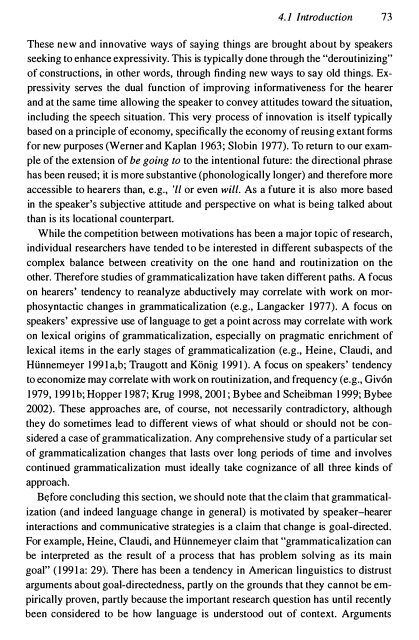Gram - SEAS
Gram - SEAS
Gram - SEAS
Create successful ePaper yourself
Turn your PDF publications into a flip-book with our unique Google optimized e-Paper software.
4. 1 Introduction 73<br />
These new and innovative ways of saying things are brought about by speakers<br />
seeking to enhance expressivity. This is typically done through the "deroutinizing"<br />
of constructions, in other words, through finding new ways to say old things. Expressivity<br />
serves the dual fu nction of improving informativeness for the hearer<br />
and at the same time allowing the speaker to convey attitudes toward the situation,<br />
including the speech situation. This very process of innovation is itself typically<br />
based on a principle of economy, specifically the economy of reusing extant forms<br />
for new purposes (Werner and Kaplan 1963; Slobin I 977). To return to our example<br />
of the extension of be going to to the intentional future: the directional phrase<br />
has been reused; it is more substantive (phonologically longer) and therefore more<br />
accessible to hearers than, e.g., 'Il or even will. As a future it is also more based<br />
in the speaker's subjective attitude and perspective on what is being talked about<br />
than is its locational counterpart.<br />
While the competition between motivations has been a major topic of research,<br />
individual researchers have tended to be interested in different subaspects of the<br />
complex balance between creativity on the one hand and routinization on the<br />
other. Therefore studies of grammaticalization have taken different paths. A focus<br />
on hearers' tendency to reanalyze abductively may correlate with work on morphosyntactic<br />
changes in grammaticalization (e.g., Langacker 1977). A focus on<br />
speakers' expressive use of language to get a point across may correlate with work<br />
on lexical origins of grammaticalization, especially on pragmatic enrichment of<br />
lexical items in the early stages of grammaticalization (e.g., Heine, Claudi, and<br />
Hiinnemeyer 1991a,b; Traugott and Konig 1991). A focus on speakers' tendency<br />
to economize may correlate with work on routinization, and frequency (e.g., Giv6n<br />
1979, 1991b; Hopper 1987; Krug 1998, 2001; Bybee and Scheibman 1999; Bybee<br />
2oo2). These approaches are, of course, not necessarily contradictory, although<br />
they do sometimes lead to different views of what should or should not be considered<br />
a case of grammaticalization. Any comprehensive study of a particular set<br />
of grammaticalization changes that lasts over long periods of time and involves<br />
continued grammaticalization must ideally take cognizance of all three kinds of<br />
approach.<br />
Before concluding this section, we should note that the claim that grammaticalization<br />
(and indeed language change in general) is motivated by speaker-hearer<br />
interactions and communicative strategies is a claim that change is goal-directed.<br />
For example, Heine, Claudi, and Hiinnemeyer claim that "grammaticalization can<br />
be interpreted as the result of a process that has problem solving as its main<br />
goal" (I991a: 29). There has been a tendency in American linguistics to distrust<br />
arguments about goal-directedness, partly on the grounds that they cannot be empirically<br />
proven, partly because the important research question has until recently<br />
been considered to be how language is understood out of context. Arguments
















